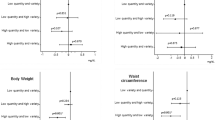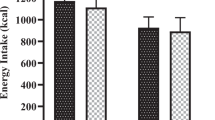Abstract
Objective:
Peanut consumption may improve lipid profiles without promoting weight gain. Both properties have been attributed to their high-unsaturated fat content. Mono and polyunsaturated fatty acids reportedly hold stronger satiety value than saturated fats and may help appetite control. This study investigated the effects of chronic peanut oil consumption on appetite and food choice.
Research methods and procedures:
A total of 129 healthy adults from three countries (Brazil, Ghana and US) were randomly assigned to one of four treatment arms: consumption of peanut oil, olive oil or safflower oil as 30% of individual resting energy expenditure (REE) for 8 weeks or no dietary intervention. Participants received no other dietary guidance. They completed appetite questionnaires eliciting information about hunger, fullness, desire to eat, and prospective consumption during all waking hours for 1 day at weeks 2 and 6 and for 1 or 3 days at weeks 0, 4 and 8. Diet records were completed at weeks 0, 4 and 8.
Results:
No differences in appetitive ratings were observed over the 8-week trial. There were no significant treatment by time interactions. Total caloric intake was significantly higher at week 8 relative to baseline (F=10.08, P<0.05). The increases for each treatment were: peanut oil=197±114; olive oil=237±121; safflower oil=274±90; control=75±71. Free-feeding intake, an index of dietary compensation, was reduced significantly at weeks 4 and 8 compared to baseline (F=9.08, P<0.00). The declines (compensation scores) were (kcals): peanut oil=−208±105 (46%); olive oil=−235±105 (50%); safflower oil=−186±102 (44%). There were no significant differences across countries in appetite ratings.
Discussion:
A prior intervention with whole peanuts reported a dietary compensation score of 66% over 8 weeks, this compares to a 46% compensation score observed with peanut oil. Our data suggests that the lipid fraction in peanuts elicits a weak effect on satiety.
This is a preview of subscription content, access via your institution
Access options
Subscribe to this journal
Receive 12 print issues and online access
$259.00 per year
only $21.58 per issue
Buy this article
- Purchase on Springer Link
- Instant access to full article PDF
Prices may be subject to local taxes which are calculated during checkout




Similar content being viewed by others
References
Fraser GE, Sabate J, Beeson WL, Strahan TM . A possible protective effect of nut consumption on risk of coronary heart disease. The Adventist Health Study. Arch Intern Med 1992; 152: 1416–1424.
Hu FB, Stampfer MJ, Manson JE, Rimm EB, Colditz GA, Rosner BA et al. Frequent nut consumption and risk of coronary heart disease in women: prospective cohort study. BMJ 1998; 317: 1341–1345.
Ellsworth JL, Kushi LH, Folsom AR . Frequent nut intake and risk of death from coronary heart disease and all causes in postmenopausal women: the Iowa Women's Health Study. Nutr Metab Cardiovasc Dis 2001; 11: 372–377.
Albert CM, Gaziano JM, Willett WC, Manson JE . Nut consumption and decreased risk of sudden cardiac death in the Physicians Health Study. Arch Intern Med 2002; 162: 1382–1387.
O'Byrne DJ, Knauft AD, Shireman R . Low fat-monounsaturated rich diets containing High-Oleic Peanuts improve serum lipoprotein profiles. Lipids 1997; 32: 687–695.
Rajaraman S, Burke K, Connell B, Myint T, Sabate J . A monounsaturated fatty acid–rich pecan enriched diet favorably alters the serum lipid profile of healthy men and women. J Nutr 2001; 131: 2275–2279.
Fraser GE, Bennett HW, Jaceldo KB, Sabate J . Effect on body weight of a free 76 Kilojoule (320 calorie) daily supplement of almonds for six months. J Am Coll Nutr 2002; 21: 275–283.
Alper CM, Mattes RD . Effects of chronic peanut consumption on energy balance and hedonics. Int J Obes Relat Metab Disord 2002; 26: 1129–1137.
Alper CM, Mattes RD . Peanut consumption improves indices of cardiovascular disease risk in healthy adults. J Am Coll Nutr 2003; 22: 133–141.
USDA. Center for nutrition policy and promotion. The role of nuts in a healthy diet. Insight 2000; 23: 1–2.
McManus K, Antinoro L, Sacks F . A randomized controlled trial of a moderate-fat, low-energy diet compared with a low fat, low-energy diet for weight loss in overweight adults. Int J Obes Relat Metab Disord 2001; 25: 1503–1511.
Piers LS, Walker KZ, Stoney RM, Soares MJ, O'Dea K . The influence of the type of dietary fat on postprandial fat oxidation rates: monounsaturated (olive oil) vs saturated fat (cream). Int J Obes Relat Metab Disord 2002; 26: 814–821.
Jones JH, Schoeller DA . Polyunsaturated: saturated ratio of diet fat influences energy substrate utilization in the human. Metabolism 1988; 37: 145–151.
Weir JB . New methods for calculating metabolic rate with special reference to protein metabolism. J Physiol Lond 1949; 109: 1–9.
DiMeglio DP, Mattes RD . Liquid versus solid carbohydrate: effects on food intake and body weight. Int J Obes Relat Metab Disord 2000; 24: 794–800.
Rolls BJ . Carbohydrates, fats and satiety. Am J Clin Nutr 1995; 61: 960S–967S.
Stubbs RJ, van Wyk MC, Johnstone AM, Harbron CG . Breakfasts high in protein, fat or carbohydrate: effect on within-day appetite and energy balance. Eur J Clin Nutr 1996; 50: 409–417.
Stubbs RJ . Peripheral Signals affecting food intake. Nutr 1999; 15: 614–625.
Friedman MI, Tordoff MG, Ramirez I . Integrated metabolic control of food intake. Brain Res Bull 1986; 17: 855–859.
French S, Mutuma S, Francis J, Read N, Meijer G . The effect of fatty acid composition on intestinal satiety in man. Int J Obes 1998; 22: 82S.
Lawton CL, Delargy H J, Brockman J, Smith FC, Blundell JE . The degree of saturation of fatty acids influences post-ingestive satiety. Br J Nutr 2000; 83: 473–482.
Alfenas RC, Mattes RD . Effect of fat sources on satiety. Obes Res 2003; 11: 183–187.
Kamphuis MM, Westerterp-Plantenga MS, Saris WH . Fat specific satiety in humans for fat high in linoleic acid vs fat high in oleic acid. Eur J Clin Nutr 2001; 55: 499–508.
Robinson SM, Jaccard C, Persaud C, Jackson AA, Jequier E, Schutz Y . Protein turnover and thermogenesis in response to high protein and high carbohydrate feeding in men. Am J Clin Nutr 1990; 52: 72–80.
Burton-Freeman B . Dietary fiber and energy regulation. J Nutr 2000; 130: 272S–275S.
Astrup A, Toburo S, Christensen NJ, Quaade F . Pharmacology of thermogenic drugs. Am J Clin Nutr 1992; 55: 246S–248S.
Blundell JE, Macdiarmid JI . Passive Over consumption, Fat intake and short-term energy balance. Ann of NY Acad Sci 1997; 827: 392–405.
Mattes RD . Fat taste and lipid metabolism in humans. Physiol & Behav (in press).
Gilbertson TA, Liu L, York DA, Bray GA . Dietary fat preferences are inversely correlated with peripheral gustatory fatty acid sensitivity. Ann NY Acad Sci 1998; 30: 165–168.
Kamphuis MMJW, Saris WHM, Westerterp-Plantenga MS . The effect of addition of linoleic acid on food intake regulation in linoleic acid tasters and linoleic acid non-tasters. Br J Nutr 2003; 90: 199–206.
Beardshall K, Frost G, Morarji Y, Domin J, Bloom SR, Calam J . Saturation of fat and cholecystokinin release: implications for pancreatic carcinogenesis. Lancet 1989; 2: 1008–1010.
Sacks FM, Appel LJ, Moore TJ, Obarzanek E, Vollmer WM, Svetkey LP et al. A dietary approach to prevent hypertension: a review of the Dietary Approaches to Stop Hypertension (DASH) Study. Clin Cardiol 1999; 22: III6–III10.
Kris-Etherton PM, Yu-Poth S, Sabate J, Ratcliffe HE, Zhao G, Etherton TD . Nuts and their bioactive constituents: effects on serum lipids and other factors that affect disease risk. Am J Clin Nutr 1999; 70: 504S–511S.
Author information
Authors and Affiliations
Corresponding author
Rights and permissions
About this article
Cite this article
Iyer, S., Boateng, L., Sales, R. et al. Effects of peanut oil consumption on appetite and food choice. Int J Obes 30, 704–710 (2006). https://doi.org/10.1038/sj.ijo.0803180
Received:
Revised:
Accepted:
Published:
Issue Date:
DOI: https://doi.org/10.1038/sj.ijo.0803180
Keywords
This article is cited by
-
Effects of fruit and vegetable, consumed in solid vs beverage forms, on acute and chronic appetitive responses in lean and obese adults
International Journal of Obesity (2013)



